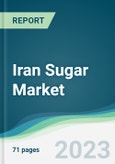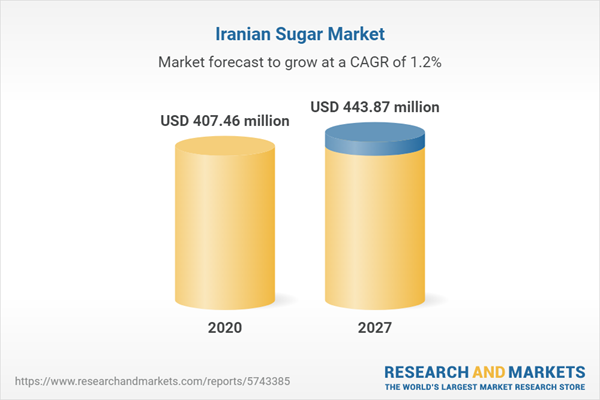The Iran sugar market is expected to grow at a compound annual growth rate of 1.23% over the forecast period to reach a market size of US$443.865 million in 2027 from US$407.461 million in 2020.
Market Overview:
Iran produces its sugar, but it also imports sugar from other nations. Iran consumes sugar at a rate that is 30% greater than the average worldwide. According to the Islamic Republic of Iran Customs Administration's most recent data, unrefined sugar reached 714,000 tons from the start of the current Iranian year on March 21 through July 12, representing a 154% increase over the same period the previous year. According to the manager of the so-called "Beetroot Project" of the Agriculture Ministry, 1.8 million tons of sugar were reportedly produced in Iran during the current Iranian year (March 2021-March 2022). Over 819,000 tons of sugar were imported into Iran in the first 11 months of the Iranian calendar year (March 2021-February 2022). Iran currently has enough sugar to supply the domestic market as needed thanks to effective planning that increased strategic supply. This amount is adequate to meet more than 70% of domestic demand.
Growth factors:
Domestic distribution efficiency
Iran's home market has a few issues, the most significant of which are an ineffective distribution system and government meddling in supply and pricing. If these are overcome, there would always be a supply of commodities, benefiting both producers and consumers. If the sugar market continues to be supplied, the amount of distribution will be lower by the end of the year (2022) than it was last year (2021).
Restraints:
Amid the anti-regime rallies that have shaken the nation for the past five weeks, workers at Iran's Haft Tapeh sugar mill in the city of Shush in the country's southwest have begun a strike. Since the protests initially started in mid-September, the economic hardship that Iranians are experiencing is a crucial component that has contributed to fueling the protests.
Market Developments:
- February 2019: The Government Trading Corporation of Iran paid in rupees from escrow accounts maintained at UCO Bank to purchase 150,000 tons of raw sugar from Indian mills for delivery in March-April. Indian sweets are regaining access to a market that Brazil, the world's largest producer, and exporter, had previously controlled. The restrictions prevent Iran from using the international banking system, including using US dollars to conduct oil sales. Iran agreed to sell oil to India in exchange for rupees, but it is only able to utilize those rupees to purchase commodities from India, primarily those it is unable to manufacture locally.
- November 2020: With Khuzestan officials present, the Farabi sugar production line began operations on Monday evening to diversify the production of strategic sugar products and unique sugar production units, such as flavored sugar and powdered sugar. In Khuzestan province, 60,000 hectares of sugarcane are expected to yield more than 600,000 tonnes of sugar this year, a twofold increase over the previous year.
Market Segmentation:
By Form
- Granulated
- Powdered
- Syrup
By Source
- Cane Sugar
- Beet Sugar
By Use
- Food and Beverage
- Pharmaceuticals
By Distribution Channel
- Online
- Offline
Table of Contents
1. INTRODUCTION1.1. Market Overview
1.2. Covid-19 Scenario
1.3. Market Definition
1.4. Market Segmentation
2. RESEARCH METHODOLOGY
2.1. Research Data
2.2. Assumptions
3. EXECUTIVE SUMMARY
3.1. Research Highlights
4. MARKET DYNAMICS
4.1. Market Drivers
4.2. Market Restraints
4.3. Porter's Five Force Analysis
4.3.1. Bargaining Power of Suppliers
4.3.2. Bargaining Power of Buyers
4.3.3. Threat of New Entrants
4.3.4. Threat of Substitutes
4.3.5. Competitive Rivalry in the Industry
4.4. Industry Value Chain Analysis
5. Iran Sugar Market by Form
5.1 Granulated
5.2 Powdered
5.3 Syrup
6. Iran Sugar Market by Source
6.1 Cane Sugar
6.2 Beet Sugar
7. Iran Sugar Market by Use
7.1 Food and Beverage
7.2 Pharmaceuticals
8. Iran Sugar Market by Distribution Channel
8.1 Online
8.2 Offline
9. COMPETITIVE ENVIRONMENT AND ANALYSIS
9.1 Major Players and Strategy Analysis
9.2 Emerging Players and Market Lucrativeness
9.3 Mergers, Acquisitions, Agreements, and Collaborations
9.4 Vendor Competitiveness Matrix
10. Company profiles
10.1. MARVDASHT SUGAR COMPANY
10.2. ESFAHAN SUGAR COMPANY
10.3. Eqlid Sugar Production and Industrial Company
10.4. Haft Tappeh SugarCane Agro-Industry Co.
10.5. Torbat Heydarieh Sugar Company
*Not an exhaustive list
Companies Mentioned
- MARVDASHT SUGAR COMPANY
- ESFAHAN SUGAR COMPANY
- Eqlid Sugar Production and Industrial Company
- Haft Tappeh SugarCane Agro-Industry Co.
- TORBAT HEYDARIEH SUGAR COMPANY
Methodology

LOADING...
Table Information
| Report Attribute | Details |
|---|---|
| No. of Pages | 71 |
| Published | January 2023 |
| Forecast Period | 2020 - 2027 |
| Estimated Market Value ( USD | $ 407.46 million |
| Forecasted Market Value ( USD | $ 443.87 million |
| Compound Annual Growth Rate | 1.2% |
| Regions Covered | Iran |
| No. of Companies Mentioned | 5 |









